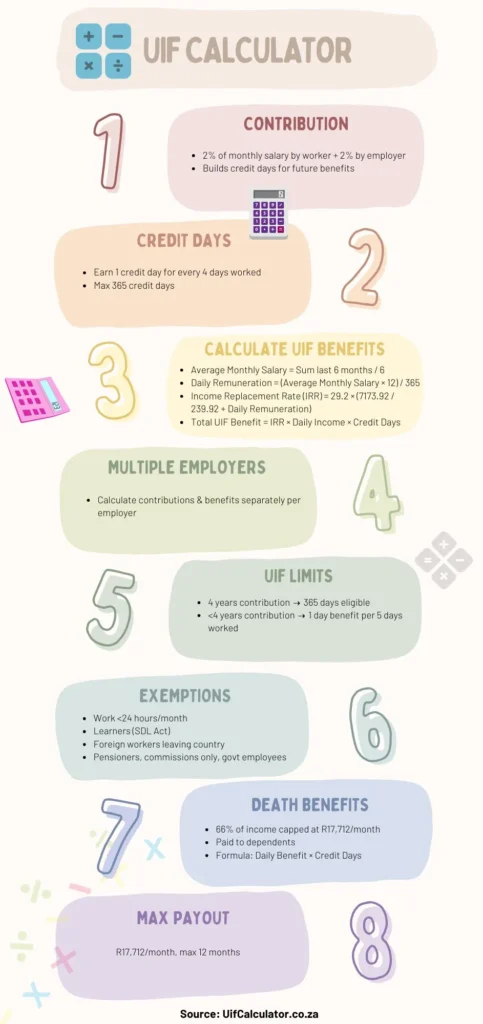For starters, 2% of the worker’s monthly remuneration must be contributed to the UIF to be deemed eligible for the insurance.
Over time, these contributions build your credit score, and you benefit in the long run when you are on leave or unemployed temporarily or permanently.
Are you planning to contribute to the program but don’t know how to calculate UIF benefits? Dive right in.
Note that your SASSA application status will be rejected if you apply for UIF benefits. You can have either one of these, not both.
How are the UIF Benefits Calculated?

- First, the UIF calculates your average salary for the previous six months. Do note that this is before you claim the UIF benefits. The base value at which UIF benefits are capped is around R17,712. You can calculate your average monthly salary using this formula; Average Monthly Salary x 6 months / 6 months.
- After this, they will calculate your daily remuneration. You can get this value by multiplying the average salary of the previous twelve months and dividing it by 356 (the number of days in one year). You can calculate your daily earnings using this formula; Average Monthly salary x 12 months / 365 days.
- The daily remuneration number is critical to the Income Replacement Rate formula. It helps you determine the percentage of daily benefits you should be awarded.
- Simply put, IRR is the number of benefits you are eligible for on a daily basis. According to the UIF chart, the minimum IRR is around 38% whereas the maximum IRR value is 60%. The formula to calculate IRR is 29.2 (7173.92 / 239.92 + Daily Remuneration).
- Finally, you can calculate your UIF benefits using this formula; IRR X Daily Income.
- Your total UIF benefit amount includes your daily benefits multiplied by the available credit days. Now, what are credit days? They are counted every four days, as you are a contributor after every four days and you receive one day’s salary.
Multiple Employers
People working with multiple employers have to calculate their UIF contributions. Every employer and employee contributes to the fund so if you’re working with more than one employer, you will calculate your UIF per income. Every income is counted separately because you work with two different companies.
If your monthly contribution is R 177 with one employer, your contributions with the other would be the same. Hence the calculation method will be the same. You just have to repeat the process to calculate your benefits.
Formula to Calculate UIF Benefits
Let us recap all the formulas you need to eventually calculate the UIF benefits.
- Daily Income for Weekly Earners = average weekly rate x 52/ 365
- Daily Income for Monthly Earners = average monthly rate x 12/ 365
- IRR = 29.2 (7173.92 / 239.92 + Daily Remuneration)
- UIF Benefits = Daily Income x IRR
Let us Understand Through an Example
Let us say you earned R15,000 per month and the benefit amount is around R10,001 during the first year of your contribution to the fund. If you worked for 260 weekdays of the year, what would be the calculations?
- Average Monthly Salary = Monthly Salary x 6 Months/ 6 Months = (15000 x 6) / 6 = R15,000.
- Average Daily Wage = Average Monthly Salary x 12 Months / 365 days = (15000 X 12) / 12 = R493.15.
- DBA or Daily Benefit Amount = IRR = 29.2 + (7173.92 / 239.92 + Daily Remuneration) = 29.2 + (7173.92 / 232.92 + 493.15) = R192.33.
- Total UIF Benefit Amount = DBA X Available Credit Days = R192.33 x 52 = R10,001.16.
Infographics on UIF Calculation

How is UIF Payout Calculated If You Have Contributed for a Short Time?
If you have contributed to the UIF payout for a shorter time, your UIF benefits will be calculated according to the credits accumulated. The formula for reduced time benefits is as follows.
- Benefits = Difference between Reduced Work Time Income (on a daily basis) and the daily benefit amount or DBA.
The differential value is your UIF benefits for the services you have contributed. If the daily income is more than the benefit amount, you are no longer eligible as a claimant and your claim will be rejected.
What is the UIF Limit?
Now, when it comes to UIF contribution, there are some ground rules that dictate the limitations. For starters, if you have been working for UIF for more than four years and have been receiving payments, you are eligible to claim the amount for 365 days. However, if the contribution is less than four years, you are only deemed eligible for one day out of every five days (applies to the work you were contributing to the UIF).
Exemptions from UIF Contributions
All employees are required to make UIF contributions unless they are exempted in accordance with the relevant laws. For instance, independent contractors deemed to be employed do not have to prove their UIF contributions. Here are the following instances during which you are exempted from contributions.
- Employees with less than 24 hours every month.
- Learners in accordance with the SDL Act.
- Foreigners who are leaving the country at the end of the service.
- People who only earn the commission.
- People receive income from pensions, retirement, or superannuation.
- Public servants, including members of parliaments and people working in any government sphere.
Is UIF Calculated On Basic Salary?
People have misconceptions regarding UIF grants for example some say that any unemployed person can claim a grant while others say that the UIF is calculated on the basic salary. First, it is not for everyone and only the people who have contributed to the UIF can apply for grants. It has a complete mechanism in which the institute carefully reviews your application.
The Department of Social Grants also gets assistance from other institutes of government in order to see the banking record, salary record, and applicant’s enrollment in other social security financial aid programs. If you fall under the eligibility criteria, you can get an insurance program; otherwise, you will be advised to apply for programs.
Additionally, retired applicants and individuals faking unemployment or fired individuals due to committing fraud are not eligible for the UIF grants. Second, UIF is not calculated on basic salary as people claim. On the other hand, the department calculates the gross salary of an individual for UIF grants.
Here you need to know the difference between gross salary and the basic salary. The gross salary is the initial amount an employee receives from the company or employer while the basic salary is the amount one receives after dedication and expenses including the UIF contribution. The UIF is calculated on the basis of the previous one, the gross salary.
An enrolled person can calculate the amount he will receive from UIF. I have provided the formula below, all you need is to put values in the formula and you will get an answer. Credit days indicate the number of days an employee worked as a contributor and the daily benefit is the amount one receives per day from UIF.
Formula
Total benefit amount = daily benefit amount x available credit days
Calculating UIF Death Benefits
Figuring out how much you can get from UIF death benefits is complicated, as the department considers various factors when deciding what you are eligible for. This includes the deceased employer’s earnings, the duration of their employment, and the contributions made to the fund. Employees working over 24 hours a month must contribute 1% of their monthly pay to the Unemployment Insurance Fund (UIF).
Additionally, the employer is obligated to contribute 1% of the employee’s monthly remuneration. If the contributor passes away, the dependents can access the funds.
Now, the main question is how the UIF death benefit is calculated. To calculate the death benefit, you can use the following formula:
Total Benefit Amount = Daily Benefit Amount x Available Credit Days
The total benefit amount refers to the overall benefit amount the employee will receive. The daily benefit amount is the amount of money you are entitled to per day from the UIF death benefit. Meanwhile, the available credit days represent the number of days for which you are eligible to receive the benefits.
It could be based on different factors like the deceased contributor’s duration of employment, contributions to UIF, or other criteria. Accumulation of credit days operates on the following bases:
- You earn one credit day every four days you actively work as a contributor. However, there is a cap on the total number of credit days you can accumulate. This limit is set at 365 credit days.
Simply put, you can continue accumulating credit days for as long as you work, but once you reach the maximum of 365, you won’t get more credits even if you keep working. In addition, the Daily Benefit Amount is calculated as 66% of your income, capped at R17,712 per month.
What is the UID Death Benefit Amount?
The UIF will provide the entire amount that the deceased employee would have received if they had become unemployed and applied for benefits from the funds. However, the sum varies for every individual due to multiple factors, such as their salary in the five years before their death, the duration of their employment, and more.
In conclusion, UIF benefits are an excellent insurance project for people who are in search of a fool-proof plan. All you need to do is contribute 2% of your monthly remuneration to the fund and receive it later when you are on leave or unemployed. I hope this guide was helpful for anyone figuring out how to calculate UIF payout benefits.
What Is The Maximum UIF Payment?
The maximum payout is R17,712 per month and R212,544 per year based on the recipient’s circumstances and the contribution. An enrolled person can receive Unemployment Insurance Funding for 12 months. In case he finds a job position during these days, his application will be declined.
The monthly payment cannot be increased whether you are a former officer or staff member. The maximum UIF payout was R14, 872 but due to the high inflation in South Africa, the government has increased the monthly maximum payout. However, no one can get more than R17,712.
